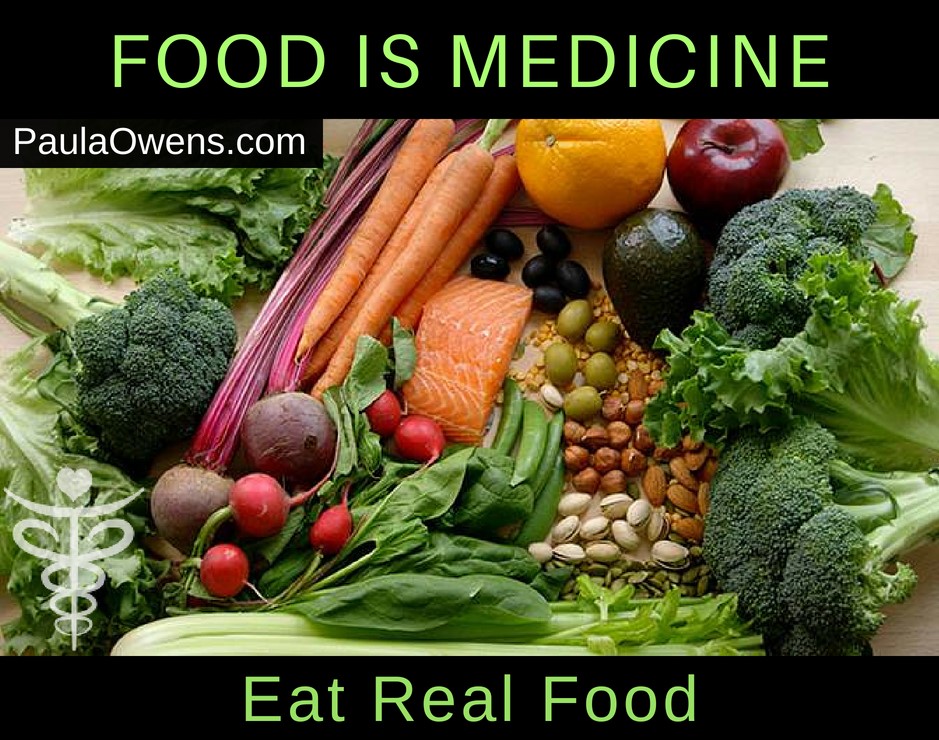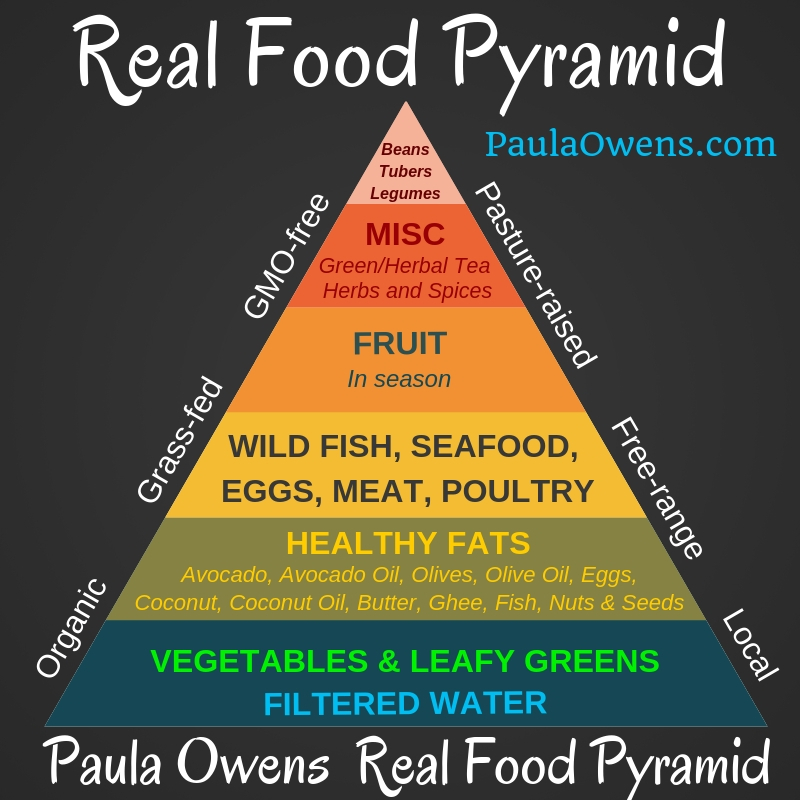Educating and Empowering You to Heal, Thrive, and Live a Happy, Healthy Lifestyle
Food is Medicine • Eat Real Food
 Food is medicine or food is poison. Food is information for your genes.
Food is medicine or food is poison. Food is information for your genes.Let’s start with what real food is not. Real food is not . . .
- Real food is not injected with hormones, antibiotics, synthetic growth hormones, GMOs and genetically-engineered ingredients
- Real food is not sprayed with poisonous pesticides, herbicides and Roundup ready glyphosate
- Real food is not found at a drive-up window or in a box
- Real food is not low-fat or non-fat
- Real food is not ultra-processed, chemically-altered, genetically-modified, highly-addictive, inflammatory disease-promoting frankenfoods
- Real food is not insulin-spiking, gluten-free treats (breads, crackers, cereals, cookies, waffles, muffins, snack bars)
- Real food does not have a long list of ingredients
- Real food does not come from a confined factory farm or from animals who are fed genetically-modified soy, genetically-engineered corn, toxic chemicals, treated inhumanly or raised in stressful, horrific environments
- Real food does not contain poisonous toxic chemicals, dyes, colors, genetically-modified soybean, corn and canola oil, artificial sweeteners, trans fats, preservatives, high-fructose corn syrup, GMOs and toxic artificial ingredients
Food is Medicine: Eat Real Food!
Is there one particular diet that is the ideal diet? After 30-some years of consulting with hundreds of individuals and their families, I have found that there is no one-size-fits-all diet.
There are many factors to take into account for bio-individuality. What I have found works best for most folks (children, adolescents and adults) is using food as medicine by choosing real foods that are nutrient-dense, anti-inflammatory, unprocessed and naturally-raised.
Real food is organic. Real food tastes better. Real food provides nourishment, satiety and prevents cravings. Real food contains higher nutrients, vitamins and minerals. Real food heals the body naturally. Real food is fuel your brain and body. Eating real foods will prevent blood sugar fluctuations, increase your energy, fuel your brain, boost and stabilize your mood, prevent age-related diseases, encourage greater fat loss, and reverse many lifestyle diseases.

Colorful Plants, Veggies, Leafy Greens, Roots & Tubers
Protein
Wild fish and sustainably-raised seafood. Fish – especially fatty fish like wild salmon, sardines, and sable fish are the only abundant food sources of the long-chain omega-3 fatty acids known as EPA and DHA. Sustainably-raised fish are also the richest food sources of three other valuable food factors: vitamin D, selenium and astaxanthin.
Grass-fed, organic, pasture-raised meats. In a study published in the American Journal of Clinical Nutrition, women on a higher protein diet that included red meat lost more weight than those eating equal calories of carbohydrates. Liver and organ meats are loaded with vitamin A (important for immunity and healthy adrenal function). The protein in red meat encourages muscle retention during weight loss and is loaded with CLA (conjugated linoleic acid), which increases metabolism helping you lose weight, boosts immune function, maintains cholesterol and triglycerides levels, and is helpful in fighting diabetes and cancer. The best sources of CLA is found in grass-fed beef, bison and raw dairy products.
Pasture-raised Eggs (if you’re not sensitive to them). Many people eat the egg white only disposing the yolk due to their fear of fat and cholesterol. When you do this, you are throwing out the most nutritious part of the egg! The egg yolk contains 43% of the total egg protein. It has the highest concentration of nutrients and amino acids required for optimal brain function. The yolk contains 100% of the carotenoids, essential fatty acids, vitamins A, E, D, & K. These fat soluble vitamins support your thyroid, reduce the damaging effects of diabetes, boost your metabolism and immune system, reduce your risk of cancer, encourage healthy bones, teeth and skin, and help you feel fuller longer. The only downside to eggs is that most folks eat them waaaay too often and end up with a food sensitivity to them.
Whey Protein is a very digestible protein full of amino acids. A study published in the Journal of the American Dietetic Association showed that women who supplemented their diets with whey protein lost weight without losing muscle mass. Whey protein boost glutathione (a powerful antioxidant) and stimulates thermogenesis (fat burning) and satiety better than casein and soy. Other studies have found that whey protein reduces appetite, as well as visceral and subcutaneous fat. Whey protein lowers blood levels of insulin and increases insulin sensitivity, which has a profound impact on body composition. Realize that all whey proteins are not created equal. Many of them are filled with highly processed denatured proteins, chemicals, preservatives, GMOs, artificial sweeteners, toxic heavy metals and other additives. Although food is the optimal choice over any powder, it can serve it’s purpose for certain individuals. If you’re going to use whey protein, make sure it is only from grass-fed cows without added hormones, steroids or antibiotics. If you’re sensitive to whey protein, opt for a vegetarian protein powder.
Healthy Fats
Coconut oil, coconut butter, extra-virgin olive oil, grass-fed ghee, butter, avocados, pastured eggs, nuts and seeds
Fat is a vital nutrient that is required for healthy brain function, fat loss, hormone balance, energy, satiety and nixing cravings, beautiful skin and hair, healthy cholesterol, a healthy nervous system, and cell membranes.
When my clients complain about weight loss resistance, dry skin, insomnia, sugar cravings, aches and pains, depression and low libido, I know they need to support their brain, hormones and metabolic functioning with more fat! Remember, eating fat will not make you fat. Just the opposite. However, the source and quality matter!

Coconut and MCT oil, a healthy saturated fat is rich in lauric acid, a medium chain fatty acid (MCT). The MCTs in coconut oil provide numerous health benefits including: Stabilizing blood sugar, hormone balance, nourishing for the thyroid, increased metabolism; contains anti-viral properties; helps reduce risk for hypertension and heart disease; and boost immunity and brain function. Metabolizing MCTs creates ketones, and ketones are known to stall or even reverse Alzheimer’s. Coconut also contains caprylic acid, an effective and potent antifungal and antimicrobial (great for Candida). One cause of obesity is overconsumption of long-chain omega-6 fatty acids (vegetable oils). Two tablespoons of coconut oil can reverse obesity, resulting in steady weight loss for obese individuals, and weight maintenance for healthy people.
Avocado. Researcher have reported that eating half an avocado at lunch increases feelings of satiation by 26%, reduces the desire to snack by 40% for the following 3 hours, and lowers risk of metabolic syndrome. Avocados provide balanced essential fatty acids to help keep your brain sharp, your skin glowing, and your heart healthy.
Grass-fed, pasture-raised ghee and butter. Butter is a rich source of butyric acid, a short-chain fatty acid (SCFA). These are important biomarkers and protectors of colon health. Just be sure to eat real butter and avoid margarine and all fake butter and oil sprays.
Raw organic nuts and seeds. Just one handful of almonds or walnuts will provide a feeling of satiety. They’re packed with fiber and contain unsaturated fat, both of which are beneficial to cholesterol levels and helpful in increasing insulin sensitivity. Walnuts have 2x the antioxidants compared to other nuts, and have 2-15x more potency than vitamin E in terms of antioxidant capacity. An easy-to-pack and carry snack that help stabilize blood sugar and reduce cravings. Remember, portion control when it comes to nuts and seeds if your goal is fat loss.
Fruits
A study published in the International Journal of Obesity reported that those who consumed more berries, colorful plants, leafy greens and vegetables had a 25% lower risk of becoming obese. Opt for a diversity of in-season, locally-grown fruits. Download the Healthy Food Shopping Guide
Berries are a nurtient-dense super food high in fiber. They help you lose that hard to get rid of abdominal fat. The polyphenols in blueberries inhibit the formation of new fats cells and help in the process to break down stored fat.
Avocados are one of my favorite nutrient dense, anti-inflammatory power foods. They’re rich in antioxidants, loaded with healthy monounsaturated fat, minerals, enzymes and fiber. The vitamin E and folate in avocado may reduce the risk of Alzheimer’s disease.
Grapefruit. Eating one half of a grapefruit daily helped people drop more than three pounds over 12 weeks. The phytochemicals found in grapefruit reduces insulin levels and increases the flow of digestive juices in the stomach.
Lemons and Limes. Add 4 teaspoons of lemon or lime juice on a salad. Add the juice from a fresh lemon or lime in a cup of warm water before meals. Doing so is nourishing for your liver, cleanses your body of unhealthy toxins, aids in digestion, and can lower blood sugar levels by as much as 30 percent!
Dark cherries are an antioxidant-rich superfood, high in potassium that help reduce inflammation and oxidative stress, lower uric acid levels, prevent gout, aid in recovery from intense training, and they’re are a natural source of melatonin.
Water and other Paula-approved Beverages
Water is a vital nutrient. It’s calorie-free, a natural appetite suppressor, aids in detoxification, pain relief, healthy brain function and fat metabolism. In a study, those who drank two cups of water before each meal lost an average of 5 pounds more weight over a 12-week calorie-controlled diet than those who followed the same diet but did not drink the water. Without enough water, your kidneys can’t function properly, which forces them to send some of their workload to your liver. Since one of the liver’s main functions is to metabolize stored fat, the added work from the kidneys means that you burn less fat. Aim for a minimum of half your body weight in ounces of filtered water daily, and more if you’re highly-active or live in a hot climate.
Coffee. Do you love your morning cup of joe? Well, drink up! Coffee can increase metabolism and has several other health promoting benefits for those who are able to metabolize it. A study published in the journal Molecular Nutrition & Food Research showed that those who drank four cups of coffee daily lost 1.5 lbs. of body fat in four weeks. Higher coffee consumption is associated with longer telomeres, which are a biological marker for healthy aging. Just make sure it’s organic because coffee is one of the highest pesticide-sprayed crops.
Green tea boosts metabolism. Six cups daily of fresh brewed, non-fluoridated green tea (or take standardized green tea extract supplements) can encourage greater weight loss and increase your fat loss efforts. The catechins found in green tea have antioxidant, anti-inflammatory, anticancer and fat oxidation benefits. A study of overweight adults consumed green tea catechins (625 mg) and 39 mg caffeine for a period of 12 weeks. The effects of moderate intensity exercise (at least 180 mins/wk) on weight loss, belly fat, and reduced triglycerides were much higher as compared to those on a control beverage containing the same amount of caffeine (39 mg), without green tea catechins. Green tea contains L-theanine, an amino acid that has both antioxidant and relaxing properties. Some studies have shown that the L-theanine may be helpful in lowering triglycerides, fighting obesity, reducing anxiety, and preventing cognitive dysfunction and stroke. A study reported in the Journal of Clinical Nutrition reported that the EGCG in green tea helps reverse breast cancer.
Bone broth is a nutrient-dense, mineral-rich, anti-inflammatory healing potion for digestion, leaky gut, inflammation, allergies, healthy brain function, joint and bone integrity, and healthy immune function.
Herbs, Spices and on the side
Chili peppers, ginger and hot, spicy mustard increase calorie burning capacity by 5–10% for up to 2 hours after eating them because they contain capsaicin responsible for amping up your metabolism.
Polyphenols and other phytochemicals found in turmeric, cocoa, green tea, coffee, blueberries, pomegranate and raw, organic honey provide endless health benefits and have been documented to have anti-inflammatory and anti-depressive properties.
Apple Cider Vinegar contains an ingredient, acetic acid, that slows the passage of food from the stomach into the small intestine and is associated with increased HDL and lower LDL cholesterol, reduced liver fats and less fat accumulation. A small amount of apple cider vinegar in a glass of water before meals is helpful for digestion, improves satiety and prevents overeating by suppressing appetite. Apple cider vinegar lowers the glycemic load of a meal, improves insulin sensitivity and prevents fluctuations in blood sugar which can influence weight loss, especially for diabetics and those who are insulin resistant. Opt for organic, unfiltered, raw apple cider vinegar.
Dark chocolate and raw cacao is high in fiber, a powerful anti-aging compound, encourages serotonin production, and helps eliminate cravings. Dark chocolate with a cocoa content of at least 70% reduces oxidative stress, reduces inflammation, has a positive influence on cholesterol, blood pressure and insulin resistance.
Cinnamon helps control post-meal insulin spikes. Cinnamon can be used to reduce the glycemic index of a meal up to 29%. One USDA study showed that just a quarter teaspoon of cinnamon/day lowered the blood sugar, cholesterol and triglyceride levels in people with type 2 diabetes.
Garlic is natural anti-bacterial, anti-viral, anti-fungal, and contains numerous healing properties It stimulates the immune system, improves circulation, lowers high blood pressure, kills intestinal parasites, and is a powerful antioxidant and antibiotic, in addition to many other health benefits.
Herbs and spices known to have a great impact on our health include ginger, oregano, rosemary and turmeric (curcumin).
Celtic sea salt contains over 80 important minerals that are required by the body proper immune, adrenal and thyroid function, electrolyte balance and for maintaining levels of fluids.
Grains such as quinoa (which is actually a seed), amaranth and buckwheat. Consume grains minimally (if at all) and be sure to soak and rinse them prior to cooking.
Yams, parsnips, sweet potatoes, roots and tubers are rich in vitamin C, potassium and beta-carotene. They’re high in fiber, but also high in starch and carbohydrates.
Beans and legumes, if you’re not lectin-resistant. They can can be problematic for some people causing digestive problems. Overnight soaking will deactivate some of the anti-nutrients making them easier to digest. Opt for organic, sprouted varieties of beans and legumes.
Fermented foods and beverages are considered food for the good bacteria in your gut. They’re essential to gut health, immune function, and help rid your body of harmful toxins. Home-made fermented veggies and sauerkraut are your best option. However, it’s important to realize that kombucha and fermented foods may pose problematic for those with yeast overgrowth and those with histamine issues.
Related posts
- Video recipe: 3 Spectacular Ways to Serve Salmon
- 30 Healthy Snacks
- Video: Frightening… and Motivating Food Facts

